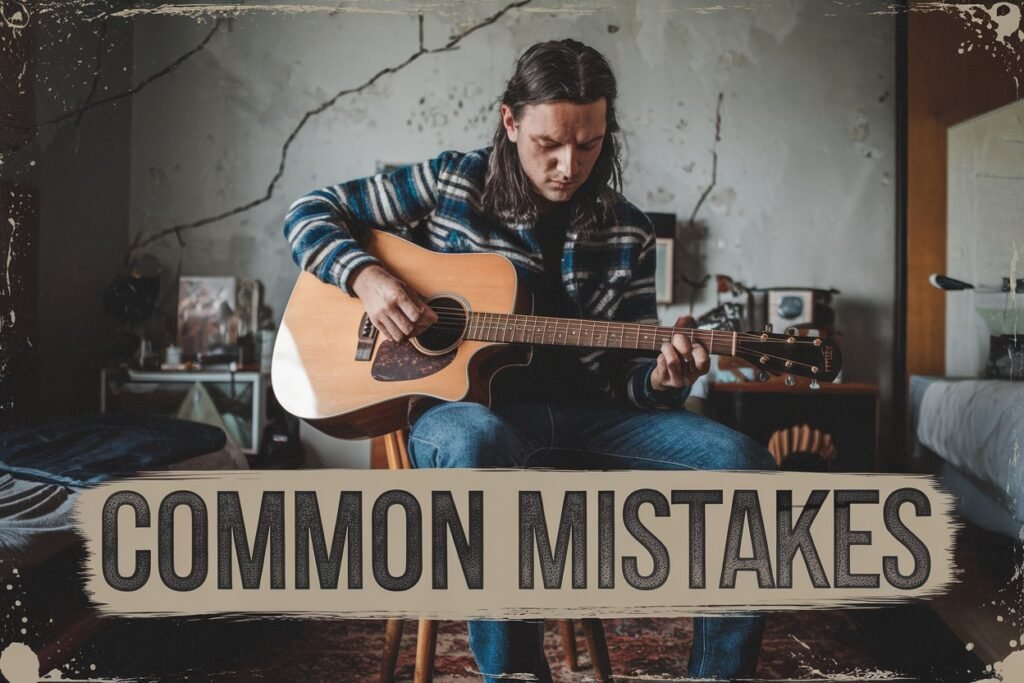Simply click the blue button below and tune your guitar with our free open G tuner with microphone!
D G D G B D
Detected Note: --
Play a string...
Hope that you enjoyed this free Open G tuner!
What is Open G Tuning, Anyway?

Open G tuning is exactly what it sounds like—when you strum your guitar without fretting any notes, it rings out as a G major chord. How’s that for instant rockstar vibes? It’s like the guitar is doing half the work for you.
The strings in Open G are tuned to D-G-D-G-B-D, which gives you a natural, rich, and powerful sound that’s perfect for blues, slide guitar, and those gritty, raw riffs.
Still not convinced? Just know that Keith Richards swears by this tuning, and if it’s good enough for him, well… need I say more?
Tuning Your Guitar to Open G (Yes, You Can Do It!)
So how do you actually tune your guitar to Open G? It’s super simple, and I’m going to walk you through it step-by-step. Don’t worry, you won’t need a PhD in music theory to get this right.
- Low E String: Tune this bad boy down a whole step to D. You’re getting the low end ready for some real grunt.
- A String: Drop it down a whole step to G. Now we’re getting somewhere!
- D String: Leave it as it is. Why mess with perfection, right?
- G String: You guessed it, this one stays the same too. Easy peasy.
- B String: No changes here either—just let it be.
- High E String: Tune it down a whole step to D.
And there you have it—Open G tuning magic at your fingertips. If you’re lazy (I mean, efficient) like me, just grab an online tuner and save yourself the hassle. Why overthink it when technology exists, right?
Why Open G Tuning Rocks (Pun Totally Intended)

Let’s cut to the chase. Why would you want to bother with Open G? What makes it so special? Well, let me put it this way: Open G gives you a gritty, bluesy sound that standard tuning just can’t touch.
You know that unmistakable rawness you hear in old blues tracks or those unforgettable Rolling Stones riffs? Yep, that’s Open G.
It’s Like Playing with Cheat Codes
With Open G, you can literally play full chords with one finger. Yes, you read that right. Want to sound like a blues legend with minimal effort? Open G’s got you. Just slide that finger up and down the neck, and suddenly you’re Howlin’ Wolf.
Oh, and if you’re a fan of slide guitar (who isn’t?), this tuning makes sliding around the fretboard feel like the easiest thing in the world. Trust me—your inner blues artist will thank you.
Artists Who Use Open G
If you’re still on the fence, let’s drop some names. Ever heard of a guy named Keith Richards?
Yeah, the guy responsible for some of the most iconic riffs in rock history, like “Brown Sugar” and “Honky Tonk Women”—all in Open G. In fact, Richards famously removes the low E string entirely, making it a five-string monster of a tuning.
Other legends? Sure, let’s add Robert Johnson to the mix. His haunting, delta blues sound owes a lot to Open G. And Ry Cooder? Yep, another Open G aficionado. Basically, if you want to sound like the greats, you’ve got to try this tuning.
Pro Tip: Open G Isn’t Just for Blues
While Open G is undeniably linked to the blues, it’s also surprisingly versatile. You can rock out to folk, experiment with alternative tunings, or even throw in some reggae vibes. Heck, if you want to play open chords all day and feel like you’re living in a Led Zeppelin album, Open G’s got your back.
How to Get the Most Out of Open G Tuning
Okay, so you’ve tuned your guitar to Open G. Now what? Let’s talk about some key things you should try out once you’re in this magical new tuning.
1. Master the Slide
Open G tuning and slide guitar go together like peanut butter and jelly. Why? Because you can easily glide between chords without having to think too much. Throw on a slide (or, let’s be real, any cylindrical object you have nearby), and suddenly you’ve got those sweet, singing notes that blues players are famous for.
2. Embrace Simplicity
Look, I’m all for complex chord shapes and fancy fingerpicking patterns, but Open G is all about keeping it simple. The beauty of this tuning is that even if you just strum open strings, it sounds good. So don’t overthink it—just start strumming, and let the tuning work its magic.
3. Experiment with Power Chords
For all my rock and roll enthusiasts, you’re in luck. Open G loves power chords. Just barre across any fret, and boom—instant chord. Slide up and down the neck, and you’ll feel like you’re writing the next rock anthem.
Open G vs. Standard Tuning: Which One Wins?
Alright, let’s do a little head-to-head here. Open G vs. Standard Tuning—who takes the crown?
Standard tuning is great for versatility and learning the basics. It’s tried and true, but let’s face it—after a while, everything starts to sound… predictable.
For those who want to tune their guitar to EADGBE – we have a tuner too!
Open G, on the other hand, is like your guitar’s wild alter-ego. It adds a distinctive tone that you just can’t replicate in standard tuning. Winner? Well, if you’re looking for unique sound and easy chords, Open G takes it hands down. (Not biased at all, I swear.)
Alternatively, you can also check out DADGAD – which is also awesome.
Common Mistakes in Open G Tuning (And How to Avoid Them)

Tuning your guitar to Open G is simple enough, but that doesn’t mean there aren’t a few pitfalls. Here’s how to avoid some of the most common mistakes:
- Not Checking Your Tuning Regularly: Dropping strings down a step (or two) means they can go out of tune faster. Check your tuning regularly to keep that rich G major sound ringing true.
- Forgetting to Mute the Low E (If You Keep It): Some players, like Keith Richards, remove the low E string entirely when using Open G. If you choose to keep it, just make sure to mute it when you’re playing those barre chords, or you’ll end up with some less-than-ideal dissonance.
- Overcomplicating Things: Remember, Open G is all about that natural open sound. Resist the urge to overthink your chord shapes—sometimes less is more.
FAQ
1. Is Open G Tuning Beginner-Friendly?
Absolutely! In fact, Open G might even be easier for beginners than standard tuning. The open strings form a full chord, meaning you can get great sounds with very little effort. One-finger chords and slide guitar are a breeze in this tuning, so even if you’re just starting out, Open G has your back.
2. Can I Still Play Regular Chords in Open G?
You can, but they might not sound exactly the same. Chord shapes from standard tuning don’t translate directly to Open G, but don’t let that scare you. With a bit of experimenting, you’ll quickly find new chord shapes and sounds that are unique to this tuning.
3. What’s the Best Style of Music for Open G?
Open G tuning is famous for its bluesy, raw sound, making it perfect for blues, rock, and slide guitar. However, don’t let that box you in—it’s also great for folk, country, and even reggae. It’s versatile enough to explore multiple genres, so feel free to get creative!
4. Why Do Some Players Remove the Low E String in Open G?
Great question! Some guitarists, like Keith Richards, remove the low E string to avoid unwanted low-end rumbling, making it easier to focus on the classic Open G sound. If you keep the low E, just be sure to mute it when playing certain chords to keep things clean.
5. Do I Need a Slide to Play in Open G?
Nope, but it sure is fun! Open G tuning is known for being ideal for slide guitar, but you can still play it traditionally with your fingers. If you’ve never tried a slide, this tuning is a great excuse to grab one and give it a shot.
6. How Do I Keep My Guitar in Tune with Open G?
Since some strings are loosened in Open G, they may slip out of tune a little easier than in standard tuning. The solution? Tune up often, especially if you’re planning to do a lot of heavy strumming or bending. It only takes a minute, and you’ll sound so much better.
7. Can I Use Open G Tuning on an Electric Guitar?
Of course! While Open G is famous for its acoustic blues vibe, it sounds just as killer on an electric guitar. In fact, Keith Richards made a career out of it, so feel free to crank up the distortion and rock out.
Final Thoughts

So there you have it. Open G tuning is like opening a hidden treasure chest on your guitar—it’s powerful, versatile, and way easier than you might think. Whether you’re a blues purist, a slide fanatic, or just a guitarist looking to break out of the standard tuning rut, Open G is where the magic happens.
Don’t be surprised if you fall in love with this tuning and never look back. Once you’ve experienced the raw power and simplicity of Open G, standard tuning might start feeling, well, a little meh. Go on, give it a try, and start writing those iconic riffs of your own! 😉





